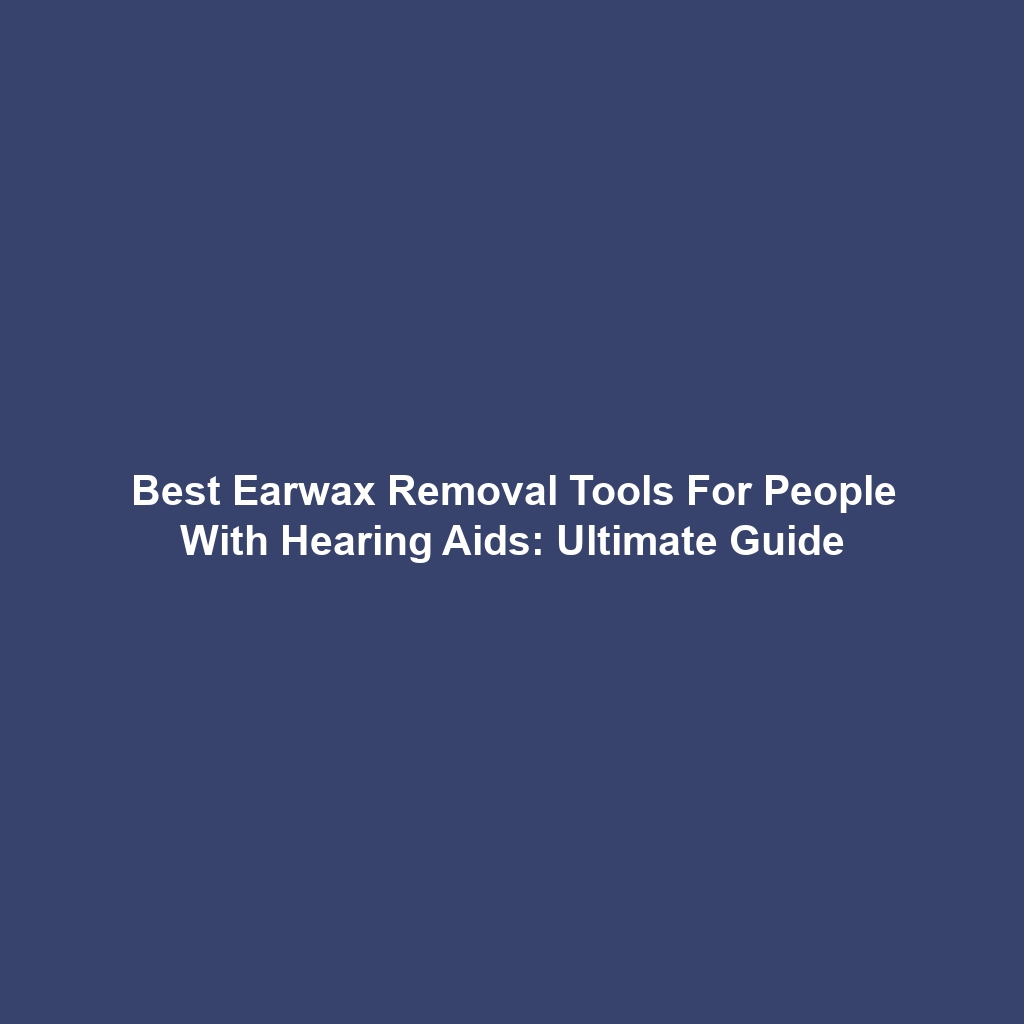Essential Earwax Removal Tools for Hearing Aid Users: Expert Recommendations and Insights
Why Regular Earwax Removal is Crucial for Hearing Aid Users: Enhancing Hearing Health
For individuals dependent on hearing aids, maintaining peak hearing health is vital for an improved auditory experience. The accumulation of earwax, also known as cerumen, can dramatically affect the functionality of these devices, resulting in muffled sound quality and potential damage to the hearing aids themselves. While earwax serves a protective purpose within our ears, excessive buildup can create a barrier that obstructs sound transmission for hearing aid users. Understanding the importance of utilizing the best earwax removal tools for people with hearing aids is essential for ensuring optimal performance.
Consistent earwax removal not only enhances the performance of hearing aids but also plays a significant role in maintaining overall ear hygiene. When earwax accumulates, it can lead to discomfort, infections, and even temporary hearing loss. For those who wear hearing aids, the sensitivity of their devices means that any obstruction can lead to frustrating auditory experiences. Addressing earwax issues proactively is crucial, ensuring that both the ears and hearing aids maintain their best possible condition and functionality.
Moreover, effective earwax removal can significantly prevent expensive repairs or replacements of hearing aids. Many users may be unaware that their devices are functioning correctly but are merely hindered by excessive wax buildup. Therefore, investing in quality earwax removal tools not only supports superior hearing but also extends the lifespan of hearing aids, making this practice essential for users seeking to enhance their auditory capabilities.
Key Factors to Consider When Choosing Earwax Removal Tools: Safety, Effectiveness, and Ease of Use
When selecting the best earwax removal tools for people with hearing aids, several critical criteria must be taken into account to ensure safety and effectiveness. First and foremost is safety. The ear is a sensitive area, and improper tool usage can lead to injuries or exacerbate existing issues. As such, tools specifically designed for earwax removal should be prioritized, particularly those that have garnered positive feedback from both users and healthcare professionals.
Effectiveness is another essential criterion. The tools must not only successfully remove earwax but do so efficiently without causing irritation. Many modern tools employ gentle methods that dislodge earwax without pushing it deeper into the ear canal—an important concern associated with improper techniques. Seek out tools designed to loosen and extract earwax without necessitating excessive force or causing discomfort.
User-friendliness is equally important, particularly for individuals who may lack prior experience with earwax removal. Tools accompanied by clear instructions or designed for effortless handling can significantly alleviate the intimidation often associated with the process. Whether it involves an irrigation kit, drops, or manual tools, ease of use can greatly influence the frequency and effectiveness of earwax removal routines.
Finally, consider insights and recommendations from fellow hearing aid users. Their experiences can offer valuable perspectives on the effectiveness and practicality of various tools, helping you select the best options available for maintaining ear health.
Comprehensive Reviews of the Top Earwax Removal Tools: In-Depth Analysis and Comparisons
In the search for the best earwax removal tools for people with hearing aids, a variety of products stand out for their safety, effectiveness, and user-friendliness. Below, we explore some of the top-rated options available on the market, offering detailed insights into their strengths and weaknesses.
1. Ear Irrigation Kits: These comprehensive kits usually come equipped with a bulb syringe and saline solution, enabling users to gently flush out earwax. They are particularly effective for individuals experiencing moderate to severe earwax buildup. Many users appreciate the non-invasive nature of this method, with minimal discomfort reported. However, it does require a certain level of comfort with self-administration, which may not be suitable for everyone.
2. Earwax Removal Drops: These drops typically contain ingredients like carbamide peroxide or mineral oil, formulated to soften earwax for easier extraction. They serve as an excellent initial step for individuals who prefer at-home treatments. It’s crucial for users to carefully follow the instructions to avoid potential irritation or allergic reactions; however, many find this method both effective and easy to incorporate into their regular routines.
3. Manual Earwax Removal Tools: This category includes ear spoons, cotton swabs, and loop tools. While these can effectively remove earwax when used correctly, there is a significant risk of inadvertently pushing wax deeper into the ear canal if not handled with care. Therefore, they should be utilized with caution and ideally under the guidance of a healthcare professional, especially for those utilizing hearing aids.
4. Electric Earwax Removal Devices: These advanced tools utilize gentle suction to effectively eliminate earwax and are rapidly gaining popularity. They provide a hands-free approach, enabling users to manage earwax buildup independently and with ease. However, they often come at a higher price point and may require some practice to master effectively.
When evaluating these tools, it’s crucial to consider individual preferences and comfort levels. Each option presents its own set of benefits and potential drawbacks, with the best choice often reliant on personal experience and specific ear health requirements. Through thoughtful assessment, users can identify the ideal tool to maintain their ear health and optimize the performance of their hearing aids.
